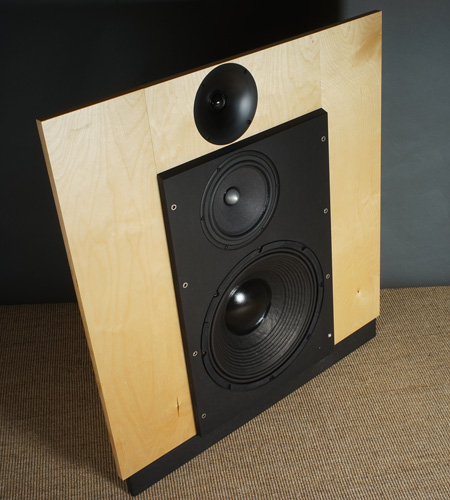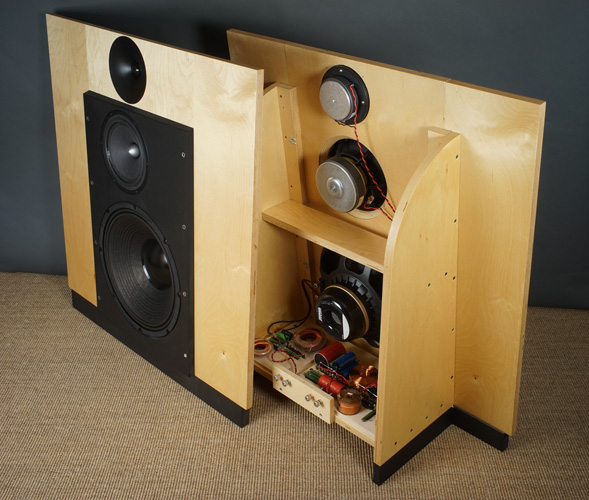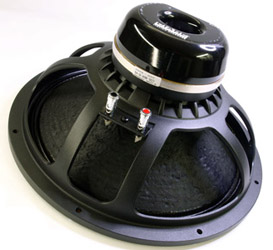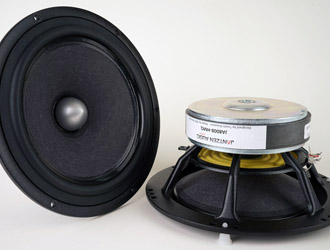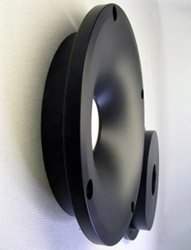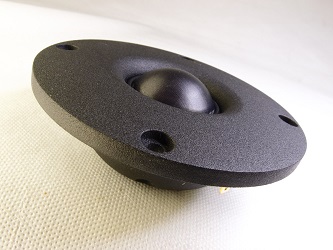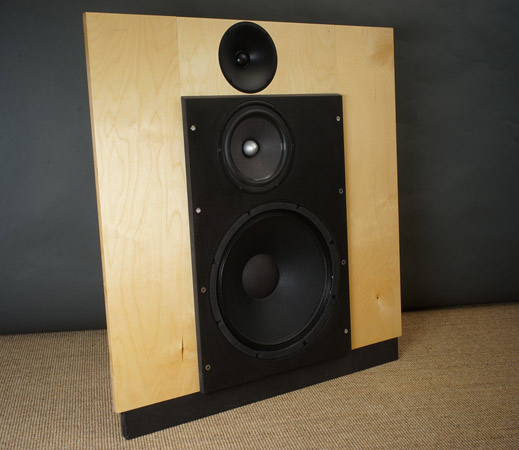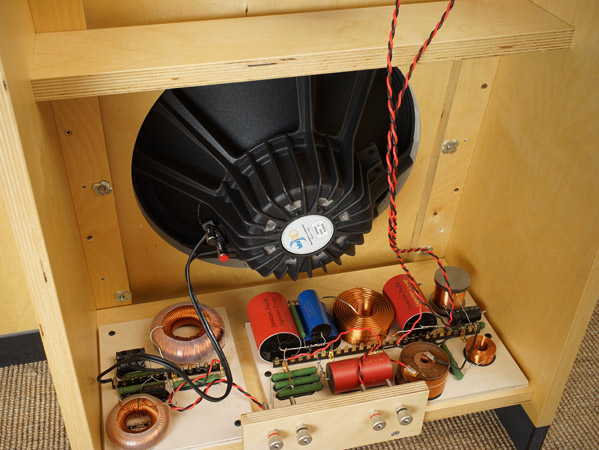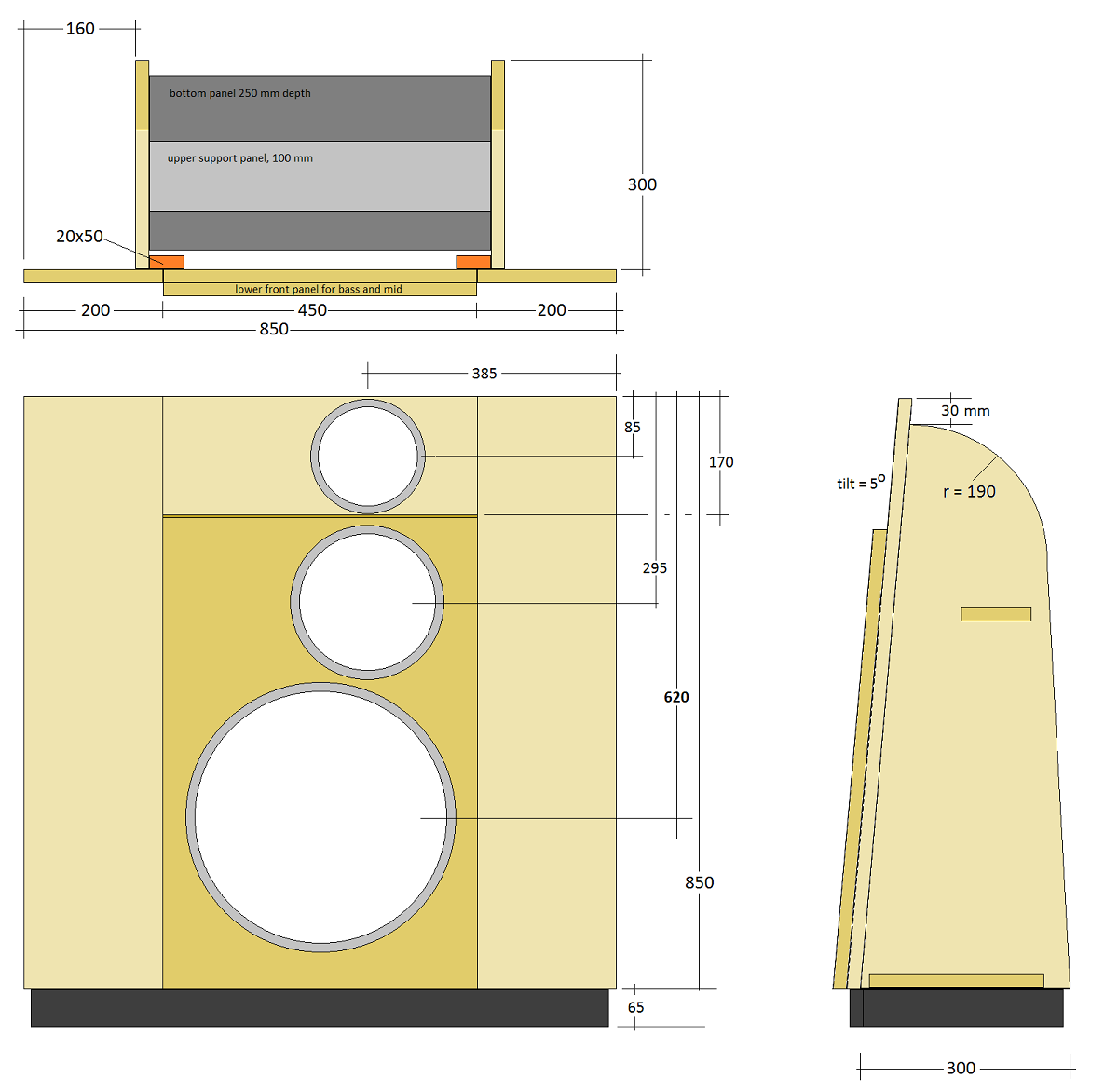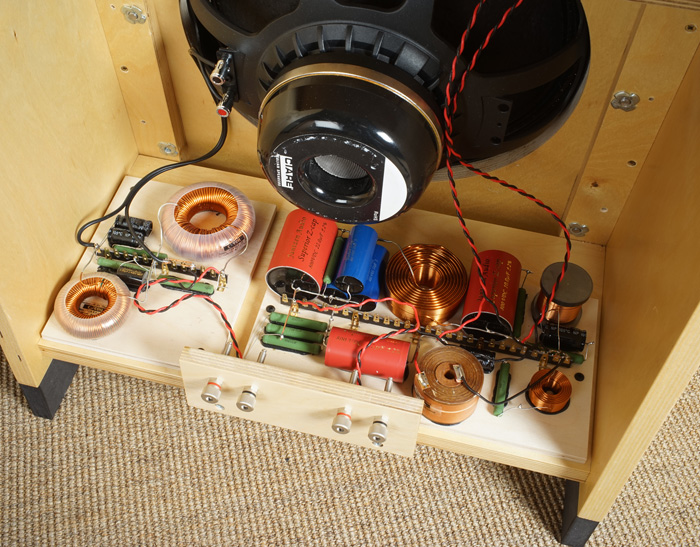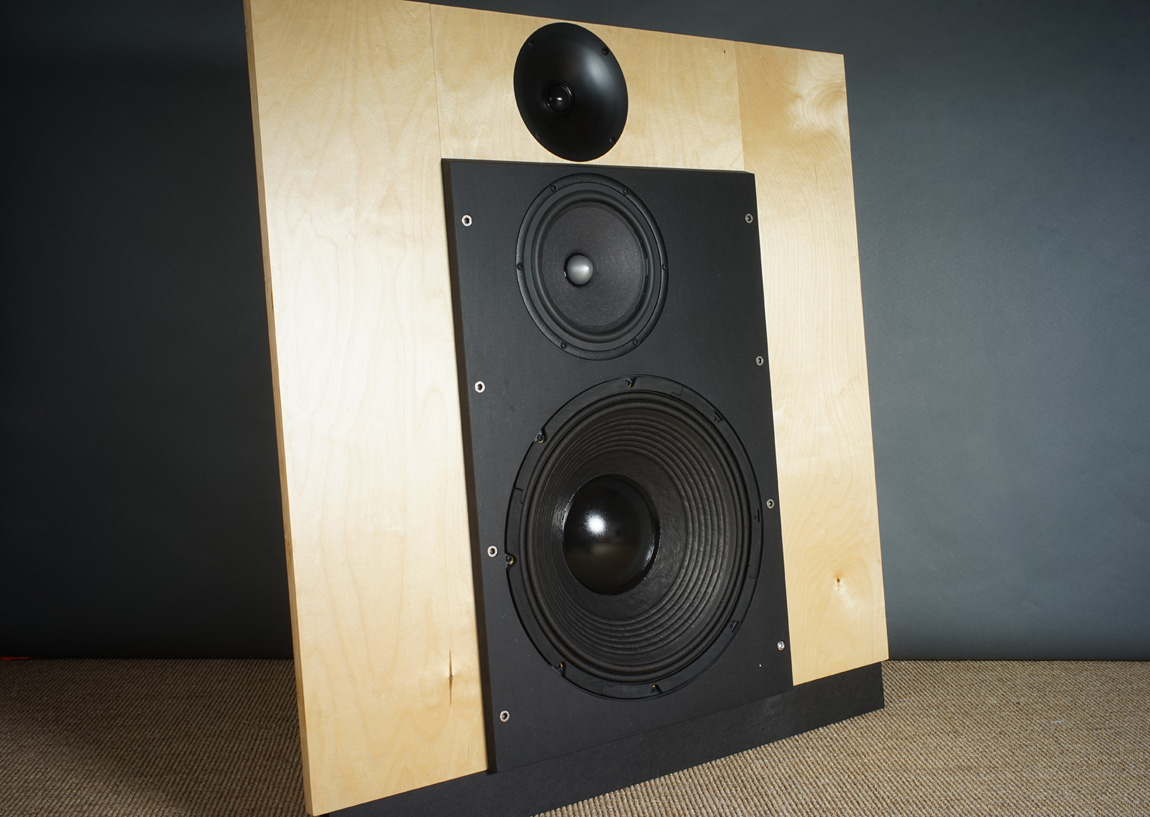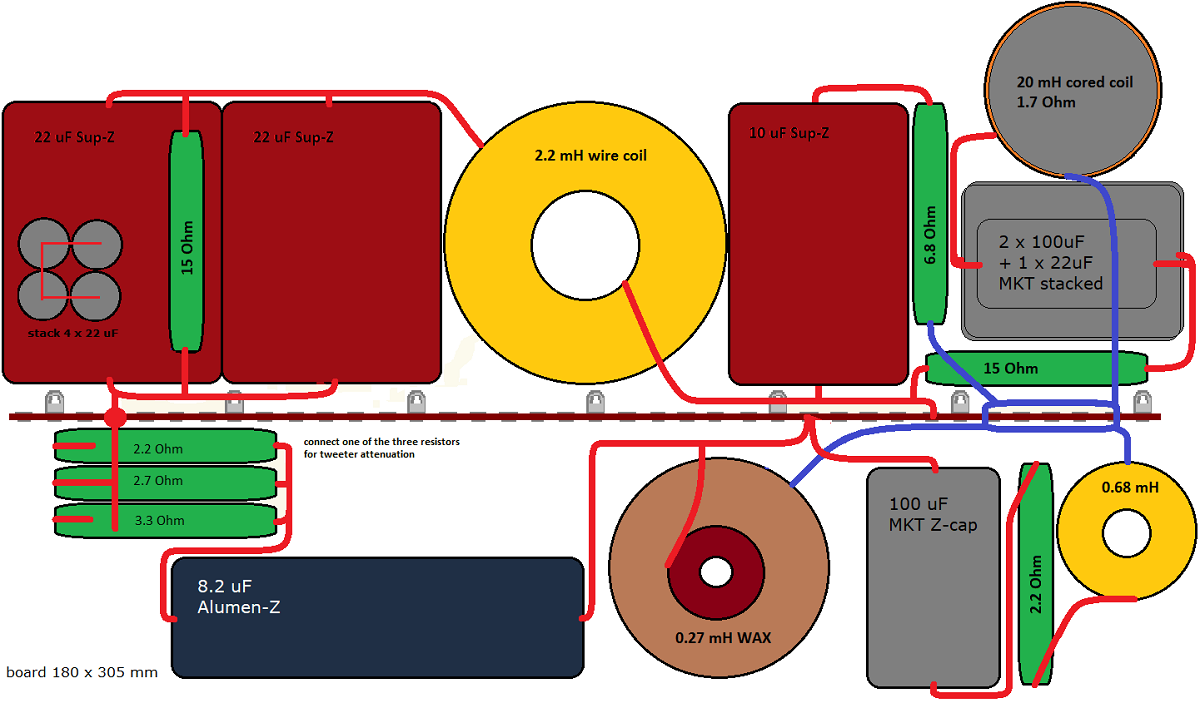DIY Loudspeakers: HOME INDEX UPDATES RESPONSE WHAT'S NEW
OBL-15
Copyright 2015-23 © Troels Gravesen
Go to on this page:
DRIVERS
CROSSOVER
BAFFLE
MEASUREMENTS
SPEAKER-KIT
CROSSOVER LAYOUT
SOUND
Since the introduction of the new
JA8008-HMQ
driver, there have been requests for an update on the OBL-11. The new
8008 driver has a different frequency response and can't just replace the old
driver in the OBL-11.
Doing my fourth open baffle, I wanted to try out a different bass driver
as well, and my eyes fell on the Ciare NDH 15-4S. Another candidate is
the Faital 15PR400, now available from Jantzen Audio.
Out of the box I measure Fs = 34 Hz on the Ciare, but Ciare
measures at 18V input (!), hence lower Fs. The Ciare features a massive
4" voice coil and a 1000 Watt (AES) power handling. I guess this will do for
the OBL-15 to put it mildly! With its 400 watts power rating (AES), the Faital is way more than adequate
for the OBL-15 and with a system
sensitivity around 93-94 dB we'll never feed this speaker any serious power.
The Faital measures Fs = 32 Hz out of the box. Quite impressive! I'm
used to PA driver showing much higher Fs compared to specifications.
Point of crossover between bass and mid has been lowered a bit, now
around 160 Hz leaving all of the midrange to the JA8008-HMQ.
Specs: Ciare NDH 15-4 S JA8008-HMQ Waveguide T35C002 SEAS T35C002
I bought the Ciare from LEAN, UK
The 8008+tweeter+crossover you get from Jantzen Audio, go to kit on this page.
SEAS T35C002: See
here how to mount waveguide.
Audax TW034 option is discontinued.
General advise: Never route for drivers before you have them at hand! Diameter can always vary a little if you want a tight fit.

FAQ:
I can't tell if any other bass driver will work, so please do not ask,
but my guess is there will be a range of suitable bass drivers. Based on
modeling the Eminence Deltalite 2515 can be used by removing R12 and C9
and as said, the Faital 15PR400 for sure. The Eminence and Faital are so
alike, I'm sure the Deltalite 2515 is OK.
Using the Faital 15PR400 I added a 1 Ohm resistor in front of the bass
crossover in order to tune to my room conditions. This resistor follows
the kit.
Basics
3-way open baffle speaker from 15 inch bass, 8 inch midrange and 34 mm
dome tweeter with waveguide.
Points of crossover 180 Hz (6-12dB) and 2 kHz (24 dB).
Sensitivity: 93-94 dB/2.8V, 1 meter
Impedance: 4-8 Ohm, minimum 4 Ohms @ 70 Hz.
Power requirement: Minimum 50 wpc if you run it from one amp. If you
bi-amp, you can run the mid and tweeter from a smaller tube amp.
Faital 15PR-400, 8 Ohm
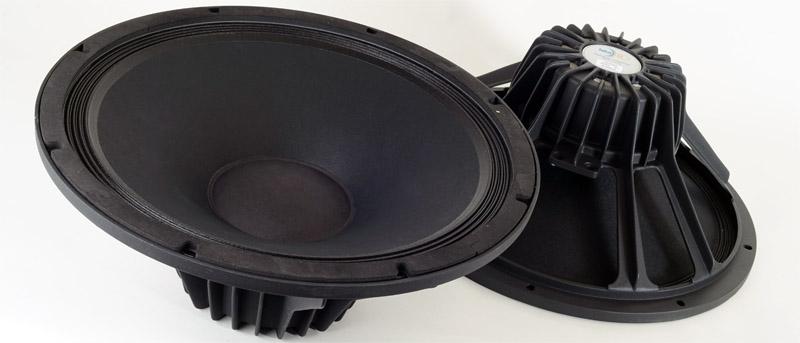
Faital 15PR-400. Click image to view large.
Download date sheet here.
Right after publishing the OBL-15/Ciare version, Eighteen Sound, another Italian speaker manufacturer, acquired the Ciare company and it will probably be some time before the full integration is in place and it is decided which Ciare products to continue and which not. The long and the short of it is that there's a shortage of NDH 15-4S drivers and I bought a pair of Faital 15PR-400 drivers for implementation. According to Murphy's Law, the Faital is 3 mm wider than the Ciare, so I had to route the black part of the front panels. The good news is that that's it! No changes to crossover or anything. Plug'n Play.
The Faital 15PR-400 is an extraordinary linear driver! This driver goes flat up to 4 kHz; a 15" driver!
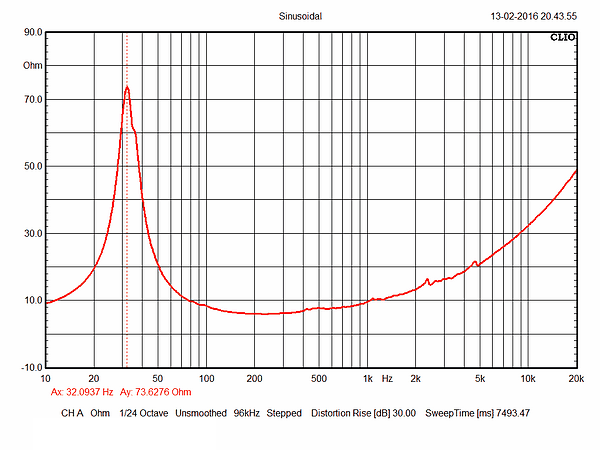
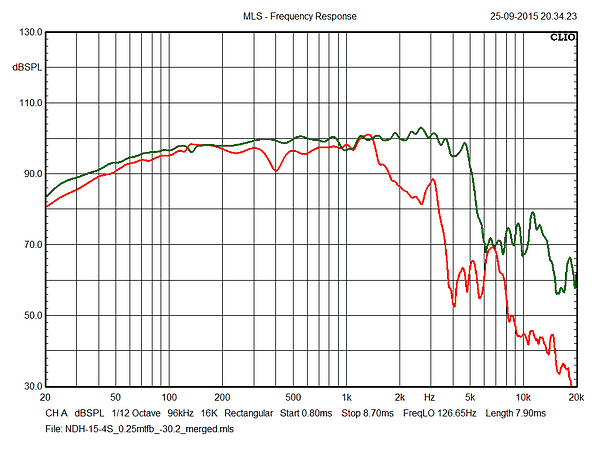
Left: Faital 15PR-400 impedance profile in free air, Fs = 32 Hz after a
little suspension massage.
Right: Comparing
the 0.25 m response of Ciare (red) and Faital green), both merged with
nearfield response @ 150 Hz. The Faital is extraordinary smooth with
only a minor dip at 1 kHz, no problem here.
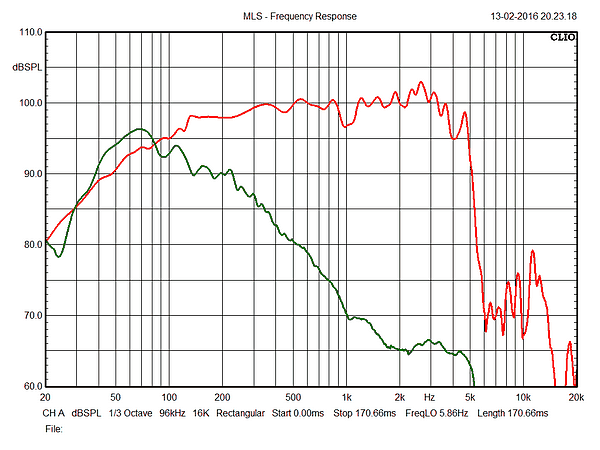
Faital measured at 0.25 m distance on baffle with no crossover (red) and
driven from crossover (green).
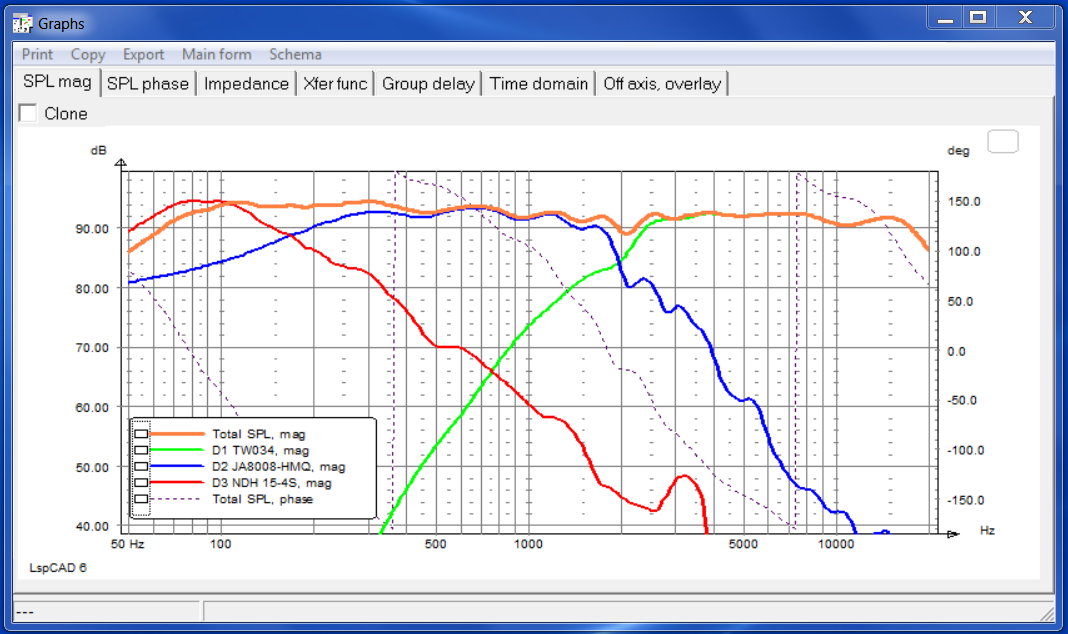
Above the final simulation. Now, the midrange usually looks anything but nice on a open baffle due to rear-wave cancellation, but driven from the very simple crossover it looks nice and smooth. Crossover between bass and mid is around 170 Hz Hz, and the crossover slopes follow an (almost) 2nd order LR topology between bass and mid and fourth order between mid and tweeter. The latter facilitates some more upper midrange presence, something that brings the music into the room rather than being a window to the music (read OBL-11 to follow the discussion). The 8008 mid has an LCR on terminals smoothing the impedance peak at 45 Hz and a resistor by-passing C3 makes a 1st order roll-off for the mid-driver. This worked better compared to a straight 2nd order filter and made a more flat response in the 100-200 Hz area - phase is not a huge issue in this area. Having the 8008 driver on a wide baffle almost leaves no baffle step loss, hence quite some response level in the 100-300 Hz range. To overcome the bump here the large chunk of series capacitors are by-passed by R14, something you will not see in any other construction on these pages.
Crossover schematics
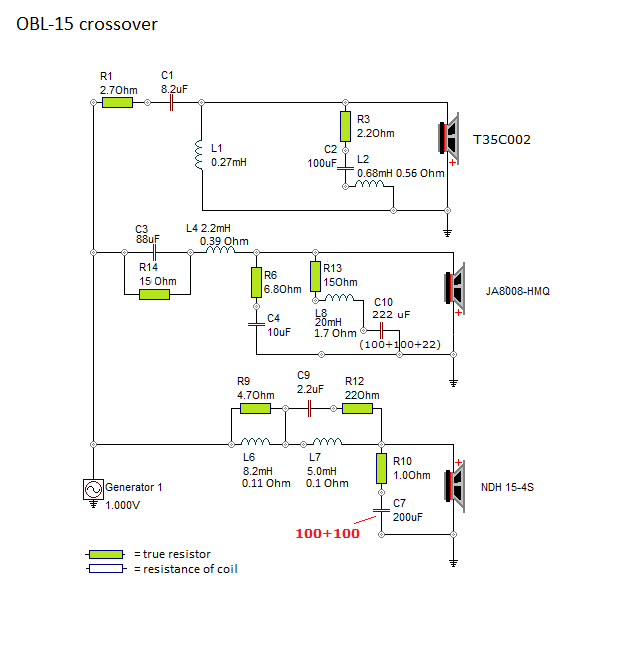
For Eminence Deltalite 2515 and Faital
15PR400 bass drivers, remove R12
and C9 (based on simulation)
Baffle size for an open baffle speaker is a matter of compromise! The
sound coming from the rear of the bass driver is obviously in negative
phase compared to what comes from the front. This means that rear
radiation will out-cancel the front radiation. Imagine a speaker with no
baffle and we have no bass; the reason we usually put a driver into a
box, either closed or vented. You can make the bass from the OBL15
deeper if you use a larger baffle than seen here, but given its size we
get a reasonable bass response. The baffle size is chosen to give a
decent bass response on level with the target 92-93 dB/2.8V system
response. A very narrow baffle will also create trouble in the midrange
response.
You should not put the speaker on spikes or lift it off the floor as the
sound waves then will travel below the panel and out-cancel bass
response. If we used a narrow baffle we would have to equalise the bass
response accordingly and we would get an overall much lower system
sensitivity. A example is the JAMO R909 open baffle speaker, which uses
2 x 15" high-efficiency drivers only to reach 89 dB sensitivity on a
very narrow baffle. On a suitable baffle we might easily make 96-99 dB
sensitivity with two 15" drivers - price to pay is size. This doesn't
mean there's anything wrong with the JAMO, only a matter of design
choices.
Use 20-22 mm panels for all parts.
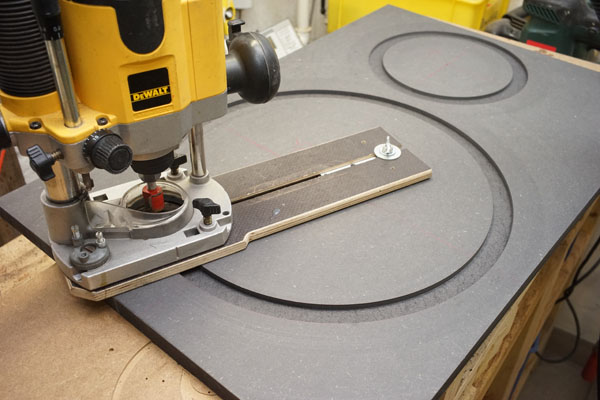
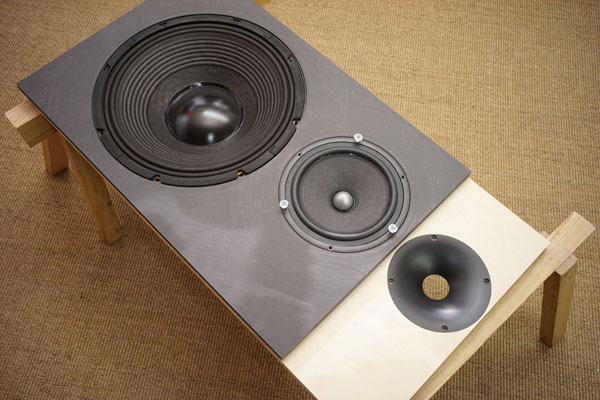
Left:
Too bad I don't route for more 15" drivers! All bass should come
from a 15" driver...
Right: Testing driver and waveguide rebates.
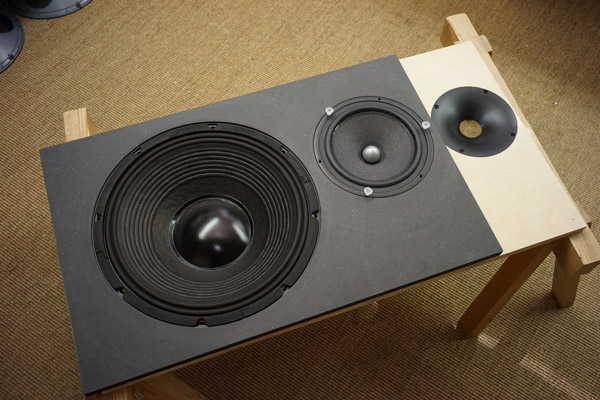
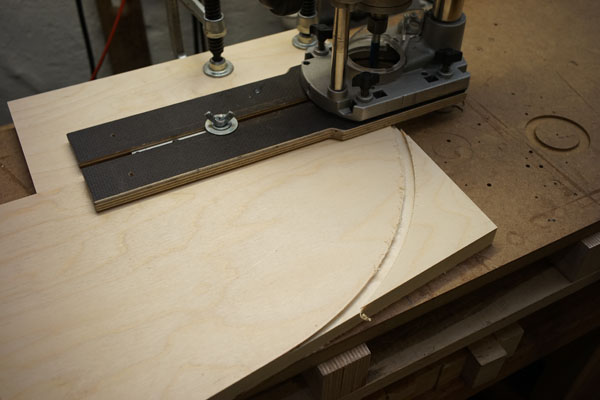
Right: Curving rear support panels.
You can make the panels much easier than mine. One-piece front + bass and mid extra panel, two rear support panels and two rear horizontal panels to keep things in place. And you can make them even better by gluing two 22 mm basic panels together to make 44-66 mm baffle thickness. Remember to chamfer 8008 driver hole accordingly! No need to chamfer bass hole. This driver is so big it has no trouble with proper ventilation.

Everything that can be counted does not necessarily count; everything that counts cannot necessarily be counted". Albert Einstein.
A few comments on MEASUREMENTS before you start
interpreting all the readings below.
First of all, if we think measurements will tell us how a speaker
sounds, we're wrong. The perception of sound is way too subjective to be
reflected in any measurements we can perform. A loudspeaker system is
meant to give us a satisfying idea of an acoustic event and for some
people a pair of 5 USD ear-plugs are enough, others spend 200 kUSD on a
truly full-range pair of speakers - and the latter may not be happier
than the former.

Above you see the same graph presented in different width. Now, we may think the graph to the right looks rather rugged, but if we stretch out the presentation (left) it suddenly look rather smooth. The left presentation is often used by Chinese manufacturers to make their frequency response graphs look better. No smoothing was used on the above measurements, but if we apply e.g. 1/6 or 1/3 octave smoothing things look even better. Just this to display how easily measurements can be manipulated to look nice.
Measurements may give us an idea of tonal balance of a system, i.e. too
much or too little energy in certain areas. Measurements may tell us
about bass extension if far-field measurements are merged with
near-field measurements. In addition to this, ports may contribute to
bass extension. Most of us diy'ers do not have access to an anechoic
room for full-range measurements from 20-20000 Hz, nor do manufacturers
for that matter.
What cannot be seen is what kind of bass performance we get in a given
room. Bass performance is highly dependent on in-room placement of your
speaker and the same speaker can be boomy in one place and lean in
another.
Actual SPL level at 1 meter distance and 2.8V input is useful for en
estimate of system sensitivity and combined with the impedance profile
may give an idea of how powerful an amplifier is needed to drive the
speaker to adequate levels.
What measurements do not tell is the very sound of the speaker unless
displaying serious linear distortion. The level of transparency, the
ability to resolve micro-details, the "speed" of the bass, etc., cannot
be derived from these data. Distortion measurements rarely tell much
unless seriously bad, and most modern drivers display low distortion
within their specified operating range.
Many people put way too much into these graphs and my comments here are
only meant as warning against over-interpretation. There are more to
good sound than what can be extracted from a few graphs. Every graph
needs interpretation in terms of what it means sonically and how it
impacts our choice of mating drivers, cabinet and crossover design.
What measurements certainly do not tell is the sonic signature of the
drivers, because cones made from polyprop, alu, Kevlar, paper, glass
fiber, carbon fiber, magnesium, ceramics or even diamonds all have their
way of colouring the sound.
The choice of crossover topology has a huge impact on the sound
we get. We may produce the same frequency response from 1st, 2nd or 4th
order filters and they may be Butterworth, Linkwitz-Riley, Bessel and
others and they all sound different, very different indeed, so take
care!
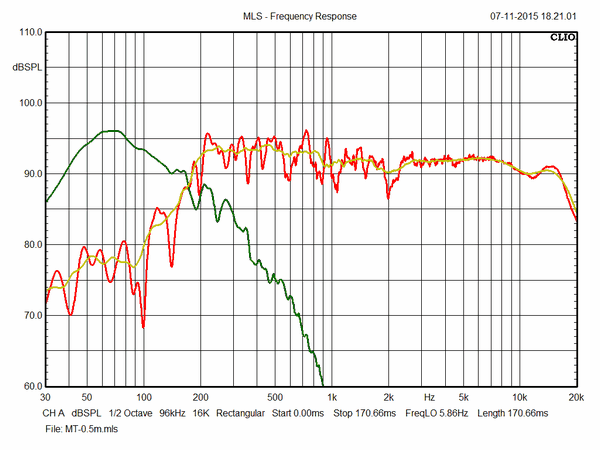
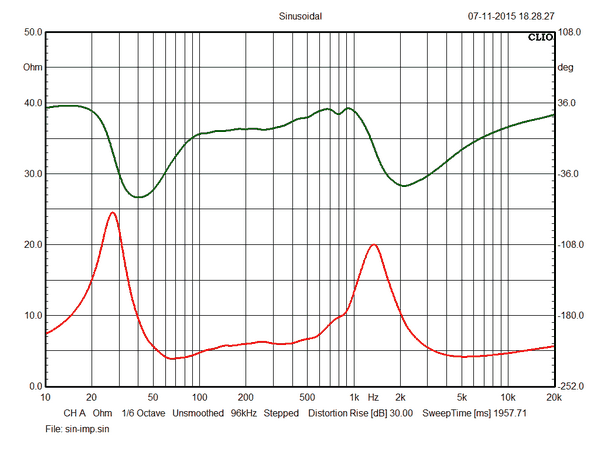
Actually I'm only going to show two measurements as they are pretty similar to OBL-11 and not least because measuring frequency response on an open baffle is a pain due to rear wave cancellation. What's show above is the MT @ 0.5 meter distance with 1/12 octave and 1/3 octave smoothing, red and yellow respectively. Green is nearfield response of bass driver. What we can get from this is a fairly even response vs. frequency around 93-94 dB/2.8V, 1 meter. To the right the impedance. This one we can get right. Minimum 4 Ohms @ 70 Hz.
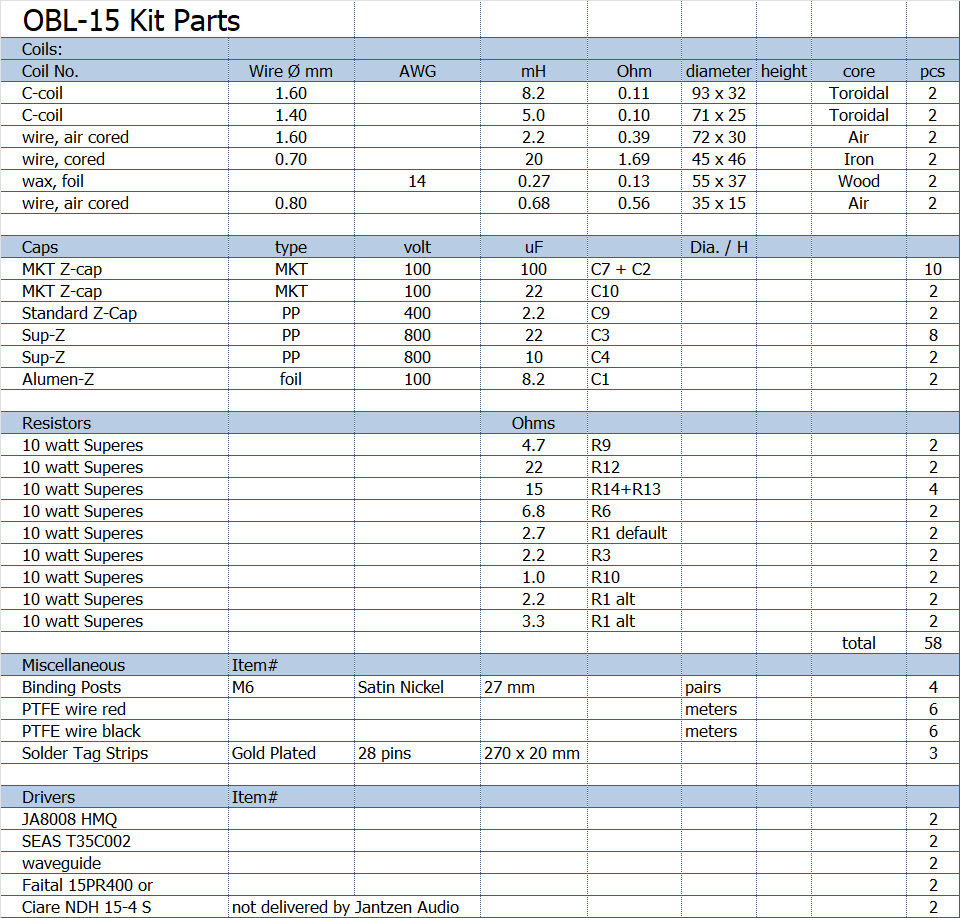
All questions regarding purchase of kits,
please mail Jantzen Audio at
contact@jantzen-audio.com
All kit and component prices may be subject to change and are always to be confirmed by Jantzen Audio Denmark.
Download Sales Presentations here
All technical questions to troels.gravesen@hotmail.com
CROSSOVER-LAYOUT
BACK TO INDEX
JA8008-HMQ - Audax TW034 LAYOUT
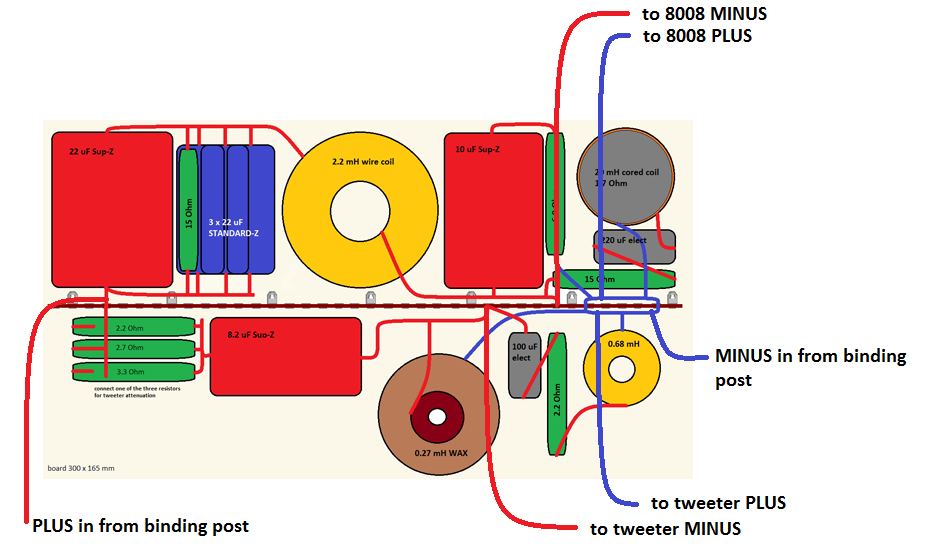
Blue STANDARD-Z caps for midrange replaced by
Superior-Z. See above.
CIARE BASS LAYOUT
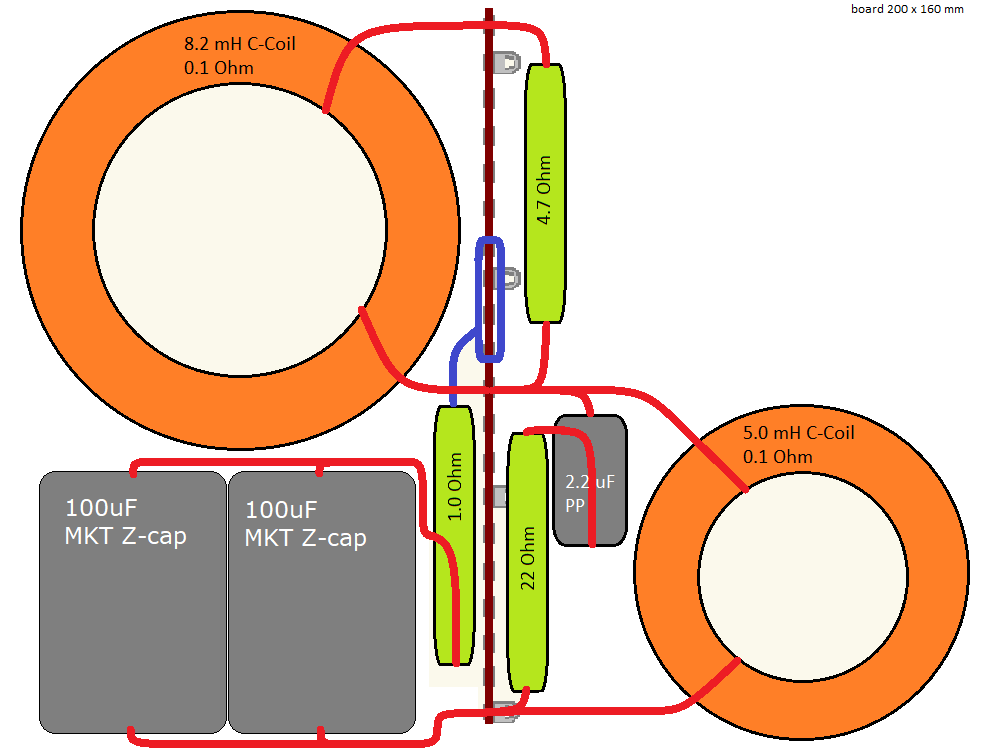
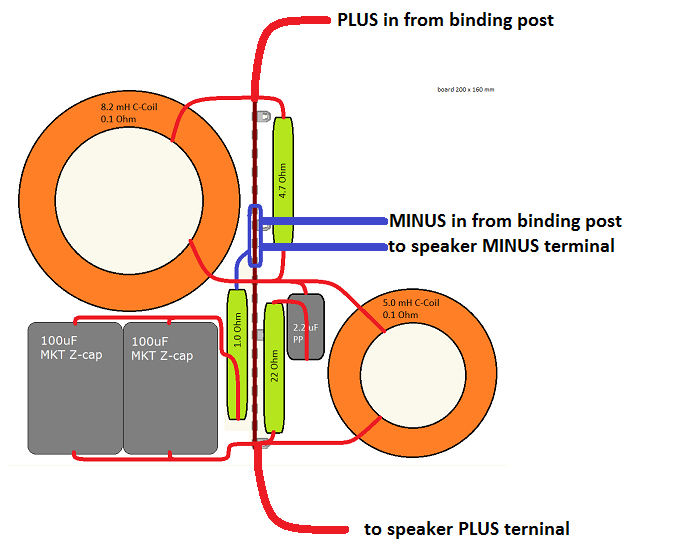
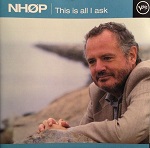
Link to youtube, click image and go to track
4, 14:09
Well, the OBL-11 was sold a few years ago (space issue) and I'd
forgotten what a 15" on an open baffle does. I knew it was good, but
that good? Frankly, the bass performance beats any other construction on these pages
regardless of price. None of my other speakers even comes close to this.
Listening to Niels Henning Ørsted Pedersen on This Is All I Ask, track
four, "Just In Time", and you'll know what I mean. The
articulation in lower registers is phenomenal and overall dynamics
scary. This is close to what an upright bass should sound like. Even the
best 10-inch driver in a reflex/closed box will never be able to deliver
such detail and transient response. Never! Price to pay is
size...
The sax solo by Phil Woods (track 7) has never sounded better in my
living room than on these OBLs. Full-bodied and vibrant as ever.

Above my workshop set-up during crossover development. Yes, you can use
these speakers in a 12 m^2 room, ½ meter to the side walls and 1 meter
to the front wall and they'll blow your brains out. The 60 years old dry
fillings in my workshop door were rattling like crazy. The bass can be
too much of a good thing is very small rooms and bi-amping is a good
thing if you can adjust level a little like I can with my 200 wpc Hypex.
Alternatively add 1.0-1.5-2.2 Ohm in series with the bass driver (at the
input of the bass crossover).
Pay notice these speakers can damage your hearing as they can play
seriously loud without distortion and we tend to crank up the volume
when we have low distortion. Tinnitus is a serious condition and I know
a couple of guys having had their lives seriously impaired by this.
It's a strange thing that mid and treble is impacted so much from the
quality of the bass, but it's true. Better bass and it pays off on mid
and treble.
